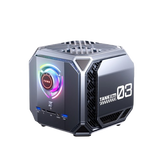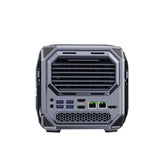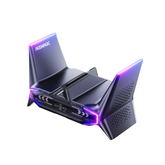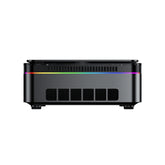Best Mini PC for HomeLab

In today’s rapidly evolving tech landscape, more and more IT enthusiasts and developers are creating their own HomeLabs at home to conduct experiments, learn, and test projects. A HomeLab not only facilitates a deep dive into technologies like virtualization, containerization, and network management but also serves as an ideal environment for daily development, testing, and experimentation. Selecting the right hardware—especially a Mini PC—is crucial to building an efficient HomeLab.
Mini PCs, known for their compact size, low power consumption, and strong performance, have become the go-to choice for many HomeLab users. This blog will recommend some of the best Mini PCs for HomeLabs, categorized by budget and needs.
What Is a HomeLab?
A HomeLab refers to a personal IT lab set up in a home environment. It can include one or more computers used to simulate and test various network configurations, servers, virtual machines, and containerized environments. Many IT professionals and tech enthusiasts use HomeLabs to learn new skills, develop projects, or simply experiment. A well-configured HomeLab enables efficient learning and testing without interfering with work or family life.
Why Choose a Mini PC for Your HomeLab?
Mini PCs save space and energy while offering great value for money, making them ideal for HomeLab setups. Compared to traditional servers or desktops, Mini PCs are smaller, quieter, and more energy-efficient, which is crucial for a HomeLab that runs for long hours. Additionally, Mini PCs can deliver sufficient computing power for tasks like virtualization, containerization, and network management.
Factors to Consider When Choosing a Mini PC
When selecting the right Mini PC for your HomeLab, consider the following factors:
- Processor (CPU): A powerful CPU is essential for virtualization and containerization tasks. Look for CPUs with at least four cores or more.
- Memory (RAM): Running multiple virtual machines or containers typically requires at least 16 GB of RAM as a starting point.
- Storage: Opt for Mini PCs with SSDs for faster boot times and read/write speeds. A 512 GB SSD or larger is recommended.
- Expandability: Choose a Mini PC that supports memory, storage, and network upgrades for future scalability.
- Network Interfaces: For enhanced network performance, select a device with multiple network ports or Wi-Fi 6 support.
Recommended Best Mini PCs for HomeLab
| Category | Model | Features | Advantages | Use Case |
|---|---|---|---|---|
| High-End Options | ASUS PN50 | Compact Mini PC with Intel Core processors. Offers a balance of performance and affordability. | High cost-performance ratio, compact, portable, easy to manage. | Ideal for users on a budget who need a balanced Mini PC for setting up a HomeLab. |
| ACEMAGIC AM18 | Features AMD Ryzen 7 7000 series mobile processors, offering strong single-core and multi-core performance. | Powerful performance, great for running large virtual machines, video editing, and gaming. | High-performance computing, virtualization, gaming servers, etc. | |
| ACEMAGIC AM08 Pro | An enhanced version of AM18 with AMD Ryzen 7 8000 series mobile processors, offering further improved performance. | Top-tier performance, ideal for users seeking extreme performance. | Suitable for handling extremely complex tasks like deep learning, scientific computing, etc. | |
| Best Value Options | Intel NUC 11/12 | High-end Mini PCs with Intel Core processors (11th/12th Gen), offering strong computing power, rich connectivity, and expandability. | Powerful performance, great expandability, well-known brand. | Suitable for high-performance computing, virtualization, and big data processing in HomeLabs. |
| ACEMAGIC & AOC Collaborate on AM16 | Features AMD Ryzen 7 processor, providing excellent multi-core performance, ideal for virtualization and multitasking. | Powerful performance, high cost-performance ratio, ideal for virtualization. | Great for running multiple virtual machines, video transcoding, machine learning, etc. | |
| ACEMAGIC AMR5 | Features AMD Ryzen 7 5000 series mobile processors, offering a good balance of performance and power efficiency. | Great value for money, suitable for entry-level HomeLab or media center use. | Budget-friendly users looking for a balanced Mini PC for HomeLab setups. | |
| Budget-Friendly Options | ACEMAGIC S1 | Attractive design with Intel Alder Lake N processors, balanced performance, and includes an LCD screen displaying system information. | High cost-performance ratio, stylish appearance, feature-rich. | Great for users with a tight budget who want a stylish and functional HomeLab setup. |
| ACEMAGIC AD15 | High-cost-performance Mini PC with Intel Core i5 processors, offering solid performance for various HomeLab applications. | Great value, solid performance, good expandability. | Budget-friendly users needing a relatively powerful Mini PC for HomeLab setups. | |
| Raspberry Pi 4 | A single-board computer, cost-effective and beginner-friendly. Although not as powerful as the other options, it can be extended to create a functional HomeLab. | Affordable, active community, and rich learning resources. | Ideal for users with a very tight budget, looking to learn about HomeLabs. |
Purchasing Tips
- Compare Configurations: Carefully compare processor, memory, storage, and interface configurations to choose the device that best fits your needs.
- Check Reviews: Refer to reviews from other users to understand the product’s real-world performance and user experience.
- After-Sales Service: Choose a brand with good after-sales service to protect your rights.
Pro Tips
- Cooling: Good thermal performance is essential, especially for long-term high-load operation. Choose models with excellent cooling designs or consider adding external fans.
- Storage: Select appropriate hard drives or SSDs based on your data storage needs.
- Operating System: A HomeLab can run various operating systems like Ubuntu, CentOS, and Debian. Ensure your chosen Mini PC supports your preferred OS.
How to Set Up and Configure a HomeLab
Here’s a simple guide to setting up a HomeLab with a Mini PC:
- Install virtualization software (e.g., VMware, Proxmox, or VirtualBox).
- Set up container environments (e.g., Docker).
- Use NAS devices for storage management.
- Configure multiple virtual machines for testing purposes (e.g., network experiments, development testing, etc.).
Frequently Asked Questions (FAQ)
Can Mini PCs support virtualization?
Most modern Mini PCs support virtualization, but ensure the CPU and memory meet the requirements.
How can I improve a Mini PC’s performance?
Upgrade memory, use faster SSDs, or upgrade network interfaces to boost performance.
Can Mini PCs serve as production environment servers?
While Mini PCs offer strong performance, traditional servers may be more suitable for heavy-load production environments.
Conclusion
Choosing the right hardware is critical when building a HomeLab. With their compact size, low power consumption, and robust performance, Mini PCs have become the preferred choice for many tech enthusiasts and professionals. By analyzing your budget and needs, you can find the Mini PC that suits you best. Whether for high-performance tasks, multitasking, or entry-level experimentation, there’s an option for everyone. We hope this guide helps you build an efficient and stable HomeLab while advancing your tech exploration.







Leave a comment
Please note, comments need to be approved before they are published.